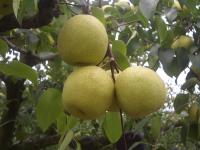
This is an Asiatic pear tree. The first sequencing of the Asiatic pear genome has recently been completed by an international consortium of seven worldwide universities and institutions including the University of Illinois.
"Our role on the team was to work on the strategy for sequencing, analyzing the data, understanding some of the biological processes, and writing the manuscript," said U of I plant molecular geneticist Schuyler Korban, whose lab had previously been involved in a consortium that sequenced the woodland strawberry genome.
"We ended up with an assembly that's 97.1 percent correct rather than 50 or 60 percent," Korban said. "Every plant genome is different, but the sequencing technologies have improved, we've learned from previous strategies, and the cost is definitely a lot less than when genome sequencing first began."
The project was developed when a professor named Jun Wu from Nanjing Agricultural University in China spent a year in Korban's lab to study the pear using the U of I apple markers.
"U of I had signed a Memorandum of Understanding with Nanjing and when Wu said that her university was interested in sequencing the pear genome that became a great collaboration."
China is the number one producer of pear. "The pear actually originated in China 65 million years ago," he said. "It's the center of the origin of pear, just like most fruits are. China is rich in germplasm."
Korban explained that there are two major varieties of pear, European and Asiatic. The sequencing was actually done on the Asiatic pear but Korban said that photos of the European pear have been used to illustrate the Asiatic variety and caused some confusion.
"The Asiatic pear looks nothing like the European pear, like the Bartlett," Korban said.
The European pear is the more familiar pear-shaped fruit, but the Asiatic pear is a round fruit that looks like a yellow apple and is often advertised in U.S. grocery stores as an apple pear.
"The Asiatic pear is the most important commercial variety in China," Korban said. "It's sweeter, has a high level of antioxidants and is healthy like the apple, but it is higher in lignified cells so when you bite into it, you can feel the grittiness, making it higher in fiber. It's also more resistant to diseases including fire blight, which the European pear is susceptible to."
Ray Ming from the U of I Department of Plant Biology contributed to the project as well as two of Korban's post-doctoral students, Danman Zheng and Awais Khan.
Awais Khan, a postdoctoral research scientist working in the Korban Lab, actively participated in coordination of groups and designing strategies for sequencing, assembly and anchoring of the genome.
"The knowledge of the pear genome will greatly facilitate comparative genomics study for identification of genes of consumer and grower interest in the Rosaceae family," Khan said. "Ultimately, this will lead to rapid improvement of the these fruits for disease resistance and fruit quality traits."
Source : University of Illinois College of Agricultural, Consumer and Environmental Sciences
 Print Article
Print Article Mail to a Friend
Mail to a Friend
